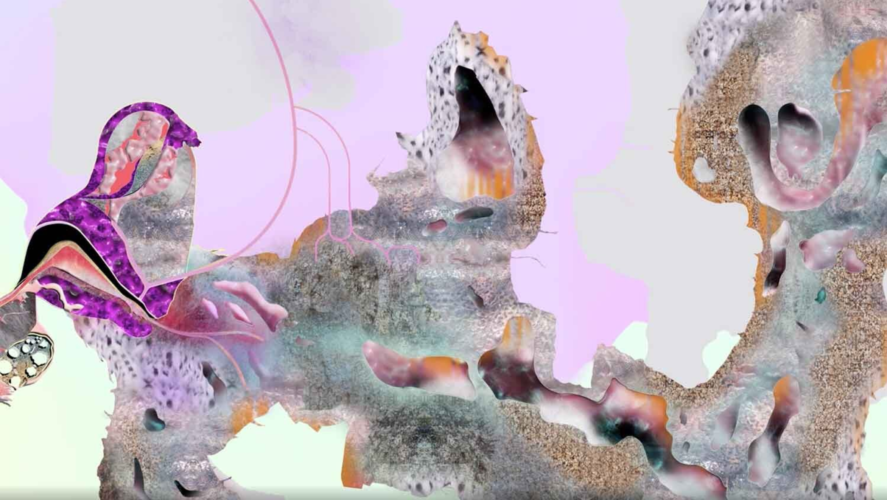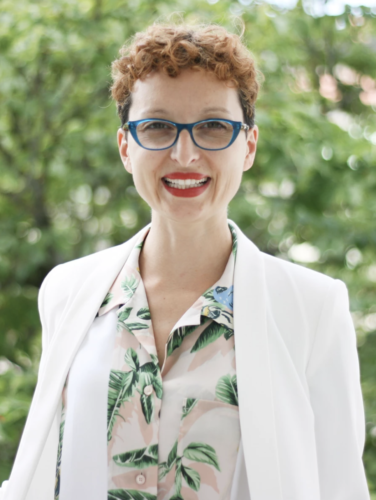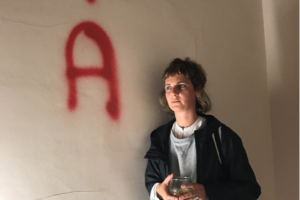Lucia Pietroiusti is a curator working at the intersection of art, ecology, and systems, usually outside of the gallery format. She is the curator of General Ecology at the Serpentine Galleries, London, as well as the curator of Sun & Sea (Marina) by Rugile Barzdziukaite, Vaiva Grainyte, and Lina Lapelyte, the Lithuanian Pavilion at the 58th International Art Exhibition – La Biennale di Venezia (and 2020-2022 international tour). At the Serpentine, Pietroiusti founded, programmes, and curates the long-term General Ecology project, a strategic, cross-organisational effort dedicated to the implementation of ecological principles throughout the Galleries’ public-facing programmes, internal infrastructure, and networks. Pietroiusti is also a co-curator of Back to Earth – the Serpentine’s 50th anniversary programme, dedicated to the environment (ongoing), which invites 65+ artists to devise environmental campaigns, prototypes, or interventions in artwork form. In 2022-23, Pietroiusti will join James Bridle in curating a section of the Helsinki Festival, dedicated to artificial and more-than-human intelligences. Publications include More-than-Human (with Andrés Jaque and Marina Otero Verzier, 2020); Microhabitable (with Fernando García-Dory, forthcoming in 2021); PLANTSEX (MAL Journal, 2019), and Sun & Sea (Marina) (2019). Lucia sits down with Adriana Trancă and takes a dive through all these wonderful endeavours.
Lucia, you are the ecology curator; how did you become interested in ecology? And what are your biggest aims or hopes in this respect, both in terms of ecological understanding as well as curatorial work? What awarenesses and climate transformations have shaped your practice?
Haha! There are many colleagues and artists who have far longer and deeper experience in ecology work than I do… The interest in ecology emerged in me, I believe, in much the same way it does for many: with what I think I’m recognising as the beginning of the second half of my life. With kids, you get to re-live your life from the beginning, but from a completely different perspective: you’re in the same room as you were three decades prior, but just sitting or standing on the other side, doing other things. There’s some weird deep wisdom in this. It emerges as a lucidity of sorts; a different sense of purpose, much more externalised. I was already involved in advocacy and activism as a student, however; particularly in pro-choice and same-sex marriage advocacy, while I lived in Dublin. So some of it is not new.
As for awareness, I think the most striking piece for me in the ecological work has to do with looking for ways to exist within a more-than-human fabric of beings. Particularly plant complexity, consciousness, and intelligence: it’s what captured my imagination most deeply and still drives much of what I try to think or do.
You are the Curator of Sun & Sea (Marina), the 2019 Golden Lion Award Winner, as well as the Curator of General Ecology at the Serpentine Galleries in London, working in a polyphonic landscape of multidisciplinary projects in and outside this institution. Could you please share what you’re currently working on?
At the Serpentine, I’m working on Back to Earth, a project that brings together artist-led environmental artworks and campaigns, as well as the General Ecology Network, which will be a distributed organisation that emerges out of the General Ecology project and brings together organisations from art and ecology to work on some very specific, mainly infrastructural transformation projects. And of course continuing The Shape of a Circle in the Mind of a Fish, the series with Filipa Ramos on more-than-human consciousness. We’re developing a book from the first four editions. Outside of Serpentine, there are a few projects – of course POWER NIGHT at E-WERK Luckenwalde, which is likely to be more of a “season” than a “night” in this slow emergence from the pandemic. The Shanghai Biennale opened recently, in April, on Bodies of Water, and Filipa and I are beginning to develop a project which will see the light in 2022.
I have to say it is a privilege to be working with you for POWER NIGHT 2021 at E-WERK Luckenwalde, together with Helen Turner and Katharina Worf, which includes the presentation of Sun & Sea in the next door derelict Bauhaus Swimming Pool. I’d like to talk a bit about the behind the scenes of this production, which to a certain extent is similar to the first presentation of the beach opera in Venice in 2019. And this extent is the difficulty in securing funding – we are currently rolling a kickstarter campaign* to raise the outstanding amounts in order to make this project happen. Could you please share some of your experiences with the Venice performances and perhaps also your thoughts on the difficulties in art productions vs. the easiness with which others capitalise on their success.
Putting on performances is really difficult, and really expensive! One of the things I realised working with Sun & Sea in Venice was that, while I had worked in live performance and time-based media for a decade, the art world, by and large, lacks the appropriate infrastructure to support it. It’s easiest to think of it as time – who, or what, can support artists during the research and development phase of the work? During rehearsals? How do we best care for a cast of performers in situations in which facilities, such as showers, changing rooms, &c, are not immediately available? These were physical, real questions in Venice, a place where we had only intermittent access to water and facilities. On top of that, Sun & Sea is a durational piece; it makes it even more important to ensure that the cast and artists are as comfortable and cared for as possible. I am not, however, so sure that anyone really capitalises on performance’s success; it doesn’t have a defined and well-established market, for example, in the way that object-based works do. I think the interest this piece draws, and the positive responses, have been crucial and incredibly well-appreciated. And those generous funders who supported the piece in Venice did that selflessly and purely out of love for the piece; there’s something really refreshing about that.
I would love to pick your brain on what kind of intellectual work you think pressingly needs to be done; what are the current (art) discourses that preoccupy you?
An interesting and complicated question – so many things interest me! But at the moment, I would say that the biggest draws for my research have to do with extractivism and other present-day manifestations of the colonial roots of the climate crisis; as well as with more-than-human consciousness in general. I’m also fascinated with different forms of “ecology,” from environmental to organisational ecology, and how to work on all of those layers simultaneously.
In a panel with Feral Atlas co-author Anna Lowenhaupt Tsing, led by you and Filipa Ramos (as part of the 2019 The Shape of a Circle in the Mind of a Fish: we have never been one), you mentioned the enchantment – when realising the ubiquity of interconnectivity, immediately followed by understanding the harmful powers of said interrelationality; it made me think about your interest in alternative worldviews, in magic, in different knowledge sharing and learning methods. And I would like to ask what places do ritual and magical thinking have in your practice?
I am reminded of the theologian Simone Kotva who once told us that theology was a brilliant place from which to study the non-human as having consciousness, without anyone objecting much. I would tend to agree with that – ritual has so much to do with our understanding of our interrelationality with non-human beings, and with our obligations towards that interconnection. And divination is, more often than not, originally to do with the weather, or agriculture. So maybe I’d say I’m more interested in what rituals hold on our behalf: what do they remember across deep time? What accreted knowledges and wisdoms do we forget when we do not investigate ritual with some degree of seriousness?
Do you yourself practice any divination rituals, Tarot reading, astro charts, automatic writing and, or any other? If not (yet), what are you most attracted to and why?
Ha! I wouldn’t say I do, not to the extent that the experts in these fields really do. I fear I over-think things a bit too much to really commit body and soul to rituals. But I do have enormous respect for some of these practices, and I’m so fascinated by their history, the codes they hold, the memory they carry with them…
How are you coping with this present state of general and perpetual trouble? How would you imagine the/a/your post-pandemic future?
There is always an optimistic and a dystopian answer to this kind of question, but ultimately I’m acutely aware that “trouble” is never equally distributed. Personally, I feel a great need to be closer together; in every sense of the word.
This historical intersection of climate crisis and health crisis presents an opportunity to really talk about care, a feminist intersectional care. Human bodies are interconnected with their environment, and it has become forever more clear that if we care about one, we must care about the other(s). How could we avoid catapulting care into buzzword territory? Or even reclaim it if it has already been taken hostage.
I am far from an expert in the notion of “care”. I like to think of “spending time with” or “noticing” as a possible alternative, for example. Yes, the cultural field tends to accelerate the use of a particular term, and often forgets those places and initiatives that have a long-established practice enmeshed in those ideas. I’m trying to steer away from fixating too much on a word, and am far more interested in the internal differences, the slippages, between practices that may be connected in language but different in methodology. In a world of echo chambers and social-media bubbles, how do we really know how much of something there is? Something may have become a buzzword among a group of people, or in a field, while being completely unnoticed elsewhere. It’s important to not seek or claim originality – it doesn’t exist anyway – but rather to make genuine attempts at understanding, attuning, appreciating. I know I am avoiding your question, somewhat… it’s only semi-intentional!
To conclude, to me it’s clear that your work is itself an act of care, but also of courage; it is grounded activist scholarship entwined with artistic engagement designed to transform the conditions of prevailing injustice and discrimination. Could you share a few of the artistic practices you’ve found inspiration in, or have short-circuited your imagination, or expanded your thinking?
It will seem strange, but I am equally as inspired by poetry as I am by systems thinking – as drawn to a beautiful artwork as I am to the bureaucratic processes that undergird it. It’s hard to name a specific artist or practice without naming one hundred. At the moment, with the Back to Earth project at the Serpentine – a project which brings together 65 artists’ works that are also environmental campaigns, initiatives or interventions – we are thinking of all the works as falling in four broad and overlapping categories. “Publics” – works that bring awareness of a specific set of issues or data to the widest possible audience; these work like traditional environmental campaigns do (we can think of Olafur Eliasson’s Earth Perspectives in this context, or of Sun & Sea in a non-Back to Earth context). “Speculations” – works that perhaps propose or suggest utopian or alternative universes; these are more like vectors – they point towards something, energetically – Revital Cohen & Tuur Van Balen’s Heavens, for example, which proposes an alternative origin myth. “Systems” – works that take to task the infrastructures that govern our present; these are more invisible, more slow and procedural works that require we get familiar with completely different and non-art environments and languages – such as Carolina Caycedo’s work towards a just energy transition. And finally “Places” – works that relate to, or wish to support, specific actual places somewhere, be it an Indigenous-led nature reserve (Karrabing’s Art Residency for Ancestors‘) or a healing centre (Tabita Rezaire’s AMAKABA). Taken in their individuality, they are situated, specific. In their disjointed, choral aggregation, they propose a complex, multifaceted response to localised, multifaceted situations. So no secret or one-trick “solution,” but rather regenerative or positive, or just attempts in the midst of trouble.
POSTED BY
Adriana Trancă
Adriana Trancă is a curator, researcher, and writer who completed a BA in Linguistics and one in Art History at the University of Bucharest (Romania) and an MFA in Curating at Goldsmiths, University ...





Comments are closed here.